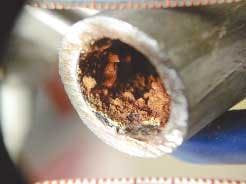Click here to enlarge imageCurrently, EPA is evaluating data in its Safe Drinking Water Information System to determine the extent of elevated lead levels at water systems throughout the country. The Agency has prepared a summary of information received as of June 1, 2004, and is scheduled to release a final report during the late summer of 2004. EPA will also evaluate and report on information related to violations of lead and copper rule requirements and other relevant information.
The Lead and Copper Rule (LCR) requires that systems conduct monitoring of lead from customer taps - generally every six months, annually, or triennially, depending on the levels of lead observed in drinking water (i.e., less frequent monitoring if levels are low). In some cases, small systems can monitor every nine years.
If 10% of the homes that are tested have lead levels greater than the action level (AL) of 15 ppb, the system must increase monitoring, undertake additional efforts to control corrosion and inform the public. For each monitoring period, a system (or the state) must calculate the lead level at the 90th percentile of homes monitored. For example, if a system monitors 100 homes, it sorts its results from the lowest to the highest concentration and reports the concentration it observed in the 90th sample.
The Safe Drinking Water Information System/Federal Version (SDWIS/FED) holds information that water systems are required to submit to states. Since 2002, states have been required to report to EPA the 90th percentile lead concentrations reported by water systems serving more than 3,300 regardless of whether the system is over the action level.
As of January 2004, EPA had incomplete data for this reporting requirement, with data in SDWIS/FED for only 23% of the systems serving more than 3,300 people. To respond to questions about the national prevalence of elevated lead levels, EPA requested that states expedite entry of the data. States were asked to submit data for large systems that serve more than 50,000 people by April; for medium systems serving between 3,300 and 50,000 people by May; and for small systems that serve less than 3,300 by the end of June. For small systems, a state is only required to report a 90th percentile if the value is greater than the action level.
On May 5, EPA released a preliminary summary of data for systems serving more than 50,000 people that reflected data retrieved from the SDWIS/FED production database on April 28, 2004.
A new summary, which is based on data pulled from the production database on June 1, 2004, updates the earlier summary to reflect additional data received and provides a preliminary summary for systems serving between 3,300 and 50,000 people.
Since the May 5 release, states have continued to upload data and made corrections to existing lead concentration and/or inventory data. Due to problems with California data in the SDWIS/FED system, EPA has pulled all California lead monitoring information from the SDWIS/FED production database. California data is being held in a separate spreadsheet pending the resolution of issues to allow for complete entry of data into the SDWIS/ FED database, which is the federal database of record for the drinking water program.
As part of EPA's review, earlier this year Acting Assistant Administrator for Water Benjamin Grumbles sent a letter to directors of state environmental and health agencies requesting information on state and local efforts to monitor and protect children from exposure to lead in drinking water at school and day care facilities.
As of June 25, EPA had received a total of 74 responses from 49 states, Puerto Rico, the Navajo nation and EPA's Region 2 office. Generally, states responded that they implemented the requirements associated with the Lead Contamination Control Act (LCCA) and continue to focus on ensuring that schools with their own water system are in compliance with the LCR.
A few states have expanded existing regulatory authorities to better address schools and day care facilities. Several states have developed specific programs that are focused on improving drinking water quality and environmental health at schools.
For additional information on EPA's Lead & Copper Rule efforts, visit www. epa.gov/safewater/lcrmr/lead_review.html.



